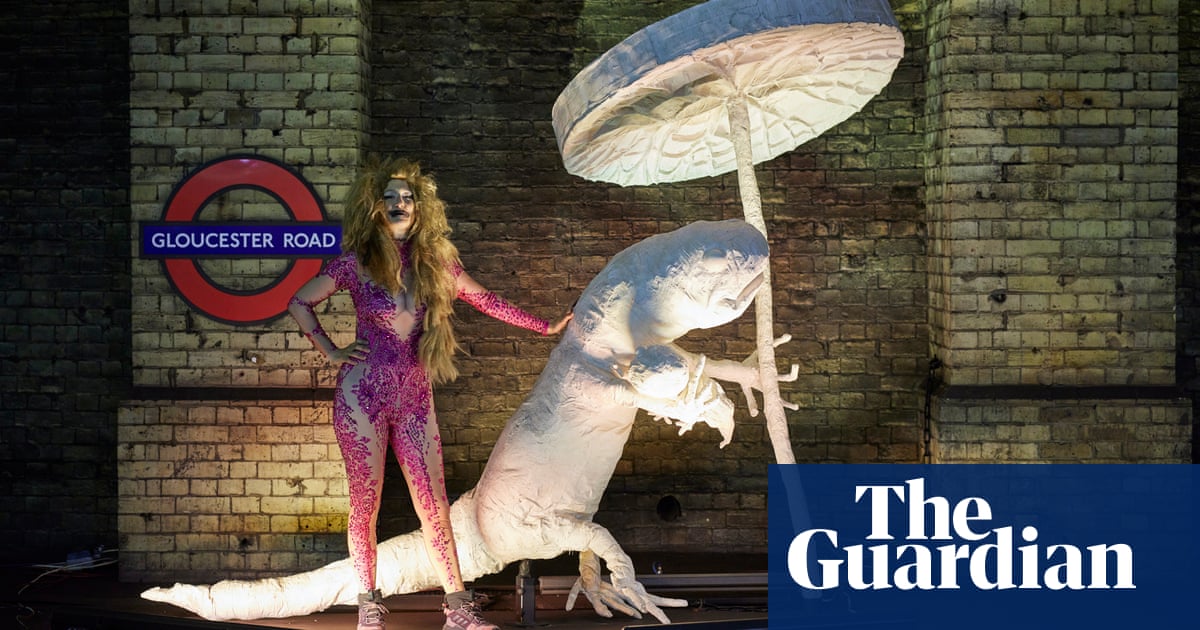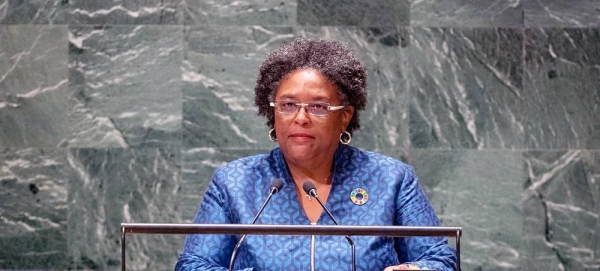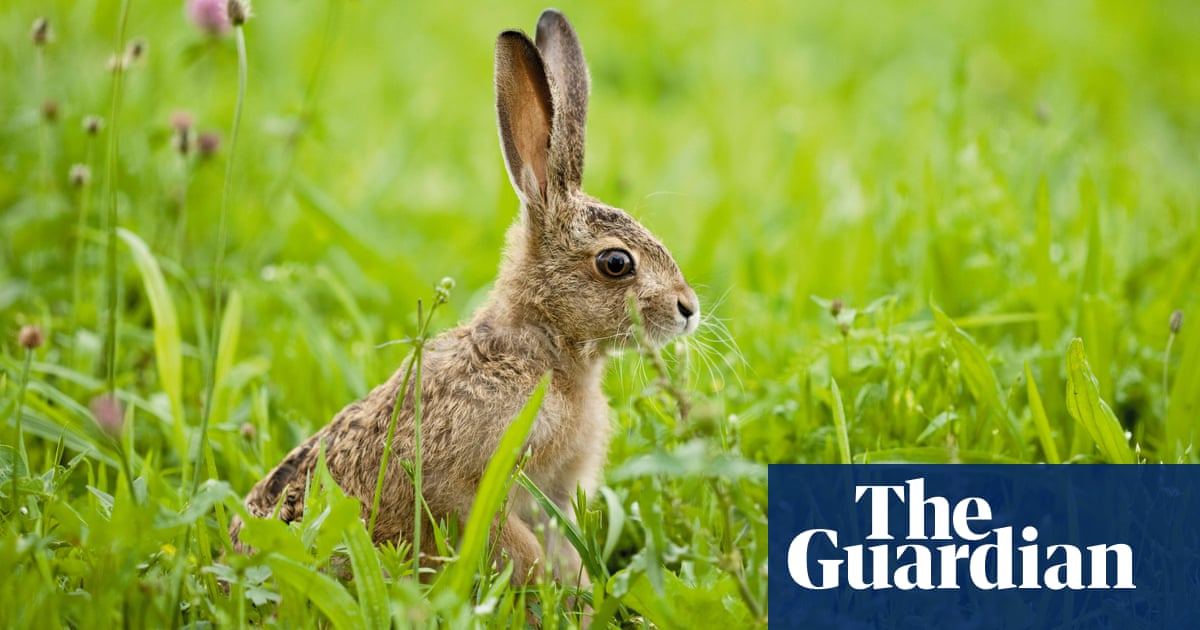
It’s rush hour, but not as you know it. On a disused train platform, a gathering of giant toads, lizards and salamanders are causing quite a stir. Groups of schoolchildren stand and point, tourists pose for selfies and sleepy commuters squint in bafflement. It’s fun standing on the platform and clocking the expressions on passenger’s faces as they trudge down the stairs of London’s Gloucester Road tube station only to be confronted by their new amphibian travel companions.
“Normally my work is linked to bad taste and disarming humour,” says Monster Chetwynd, the artist behind the sculptures. “But these look oddly delicate, almost like Wedgwood porcelain.” While Chetwynd’s trademark childlike charm is present in the works, they’re less outrageous than some previous pieces. This, after all, is an artist who is making an ongoing film project – Hermito’s Children, begun in 2008 – about a transgender detective trying to solve the case of a woman who orgasms herself to death on a dildo seesaw (“Silly beyond words and teetered on the edge of porn,” wrote one Telegraph critic, before admitting: “I defy you to tear yourself away”). She also created a gothic, monochrome softplay centre called The Idol (sadly now closed due to Covid, rather than the fact it looked terrifying), lit up Tate Britain with gigantic, luminescent mating slugs and painted a wall with her bare bottom.
Chetwynd’s works are often performance based. She might rope in friends, family or random people she recently met to dress up in handmade costumes of warped woodland creatures or ancient historical figures, and prance around looking like they’re having a blast. In one, they walk from London to Dover dressed as Dickensian street urchins, making the link between Victorian debt prisons and modern credit card culture along the way. In another, a man metamorphoses into a potato in tribute to the artist Eduardo Paolozzi.
And this latest commission – for Transport for London’s Art on the Underground series – comes with a film called Pond Life: Albertopolis and the Lily, in which Chetwynd adopts the role of a “fact-hungry witch”. Dressed in a sparkly pink bodysuit and wild blond wig, she travels via tube and broom to investigate colonialism, the history of the Amazonian lily and the nature of truth.
Being Monster Chetwynd – who was born Alalia Chetwynd but changed her first name to Spartacus, then to Marvin Gaye, then Monster – seems like a lot of fun. But as she points out, the finished works don’t show all the 5am starts, the mad rush to sew costumes or the immense amount of research they require. “I’m determined and dogged,” she says. “Because I know what it takes to make something effortless and light and joyous.”
We’re speaking in the station control room, a tiny office crammed with hi-vis jackets. Chetwynd is dressed in her witch costume today, complete with smeared black mouth paint, and she is great, if rather unusual, company. Typical quote: “You’re probably not interested in this story, but I kind of don’t really care.” She has a tendency to go off on tangents (Estonian attitudes to breastfeeding) but she does answer questions in great detail. Just not always the ones I’ve asked. “I know I annoy a lot of people,” she says at one point, laughing. “I’ve got a lot of friends who say, ‘Oh God, I can’t cope with you. I can’t even be friends with you!’”
Chetwynd loves the tube, though her stories of why are a little outré. “I remember seeing a person on there who was sweating blood,” she says. “And I also saw a person who had six fingers. So they were reading a newspaper and using their sixth finger to hold the pages in an interesting way. That felt quite Men in Black – like there’s lots of fun aliens among us. If only!”
This new underground installation was inspired by the 1851 Great Exhibition in nearby Hyde Park, a soaraway world’s fair that helped raise funds to build the great educational buildings on Exhibition Road. It harks back to a time when Britain was an international powerhouse, but that doesn’t interest Chetwynd, who cares more about the craft that went into building Joseph Paxton’s gigantic Crystal Palace, which housed the exhibition. “To read that each pane of glass was individually hand blown – I get really genuinely excited about things like that.”
Chetwynd’s unconventional art arose from an unconventional upbringing. Her father Rupert, who died in 2021, was a captain in the Grenadier Guards and an adventurer who brought medical supplies into Afghanistan, while her mother Luciana Arrighiwas an Oscar-winning set designer. The family travelled around in campervans – Hong Kong, Australia, Malaysia, Pakistan – absorbing the world. Yet by the time she was 10, Monster still couldn’t read or write. “I remember people being shocked that I didn’t know the alphabet,” she recalls. “But I had incredible confidence – and no understanding that they thought I was inferior for not knowing something they held very highly.”
Chetwynd describes her upbringing as a kind of experiment, although if she weren’t laughing as she told the story it might sound rather cold: “My parents are meritocrats, and they were very upfront about the fact that they just weren’t going to bother with us if we weren’t bright.” She recalls being sent for intelligence tests with her brother. Only after scoring highly were they “patted on the back and told we’d have a bright future”.
After various encounters with inspirational teachers – including one who apparently walked into the classroom on his hands only to flip over and start reading poems – Chetwynd studied social anthropology and ancient history at University College London before training in art. That first degree still influences her work, with much of it based on arcane ritual: colourful, costumed carnivals that run amok in the fresh air, free from the stilted confines of the gallery.
She accepts that she gets patronised by critics. “Hardly surprising,” she says, gesturing at today’s outfit. But she remains resilient. “I believe art is a smorgasbord,” she says. “And I believe in artists bringing all types of dishes to the table. Even if the other ones look like they dominate sometimes – like conceptual art – my dish is still welcome. It’s like the little chilli next to the eggs. Do you know what I mean?”
In 2012, Chetwynd became the first performance artist to be nominated for the Turner prize. Her solo show at the time was Odd Man Out, which involved voting booths, a puppet re-enactment of the story of Jesus and Barabas, along with an inflatable slide between levels of the gallery. But she also enjoyed messing with the very fabric of the award itself. “I pretended that I lived in a nudist colony,” she says. “And they went and put it on the wall text, just like that. I find it phenomenal that within the rigours of an institution you can get away with stuff like that.”
The story must have stuck, I say, because I’d read that she really did live in a nudist commune – by a nature reserve in Nunhead, London. “Well, that was more like a communal flat,” she says. “It wasn’t like 20 people, it was five. And we weren’t nude all the time because it was cold – only if it was fun and warm.” Well that clears that up, then.
Chetwynd was pregnant when she was nominated for the Turner and her son Dragon was three months old at the time of the award ceremony. (The prize went to Elizabeth Price.) There are debates currently around providing more support for artists with children, but Chetwynd doesn’t think being a parent inhibits her output. “I’m quite defiant about stuff like this,” she says. “The problem with having meritocratic, workaholic parents is that I would say that artists don’t need chaperoning and don’t need support and don’t need to be given all this stuff, because it’s like – they’re just going to do it regardless.
“But I have to be careful because, although I was raised in caravans, I was constantly told I could do anything I wanted. It was sort of this nightmarish whisper, ‘You can do anything, anything.’ So there’s part of me that thinks I am going to do whatever I want and no one’s going to stop me. And then you put that together and realise it comes from quite dark politics.”
Chetwynd is currently based in Zurich, where she has a post at the university, and is transforming her unused parking space into a miniature art exhibition. But she will return to the UK this summer for a show at Mount Stuart House on the Isle of Bute on Scotland’s west coast, inspired by its moth population. Her eyes light up talking about the elephant hawk moth (“bright green and pink and shaped like a Harrier bomber”) and the garden tiger moth (“It has the ability to outwit bats with sonar!”).
In fact, much like her stories about tube adventures (the screaming woman who needed directions, the elderly lady licking boyband posters), she can talk about moths at surprising length. Chetwynd just has an insatiable lust for life, for people, for nature, for stories. “I know it looks like I’m an ego diva,” she says, gesturing at her outlandish outfit once more, “but to be honest, I’m a real observer. I actually spend a lot of time being an audience member – of life.”










